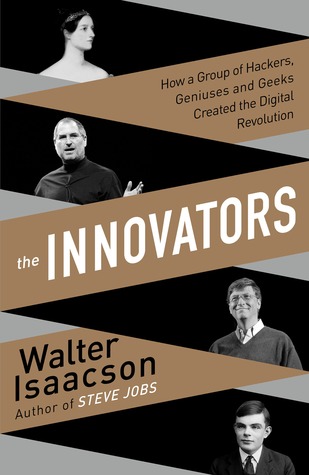The Innovators: How a Group of Hackers, Geniuses, and Geeks Created the Digital Revolution

Summary: The computer and the internet are among the most important innovations of our era, but few people know who created them. They were not conjured up in a garret or garage by solo inventors suitable to be singled out on magazine covers or put into a pantheon with Edison, Bell, and Morse. Instead, most of the innovations of the digital age were done collaboratively. There were a lot of fascinating people involved, some ingenious and a few even geniuses. This is the story of these pioneers, hackers, inventors, and entrepreneurs—who they were, how their minds worked, and what made them so creative. It’s also a narrative of how they collaborated and why their ability to work as teams made them even more creative.
Review: I won a copy of this book as a giveaway on Goodreads.
The Innovators is a serial biography of the many who contributed to the Digital Revolution beginning with Ada Lovelace in the 1800s and ending with Google in the late 1990s. Isaacson's whole premise is that innovation relies heavily on creative teams and collaboration, all building off of the work of others, rather than a single person working in isolation. "Innovation is usually a group effort, involving collaboration between visionaries and engineers, and that creativity comes from drawing on many sources. Only in storybooks do inventions come like a thunderbolt, or a lightbulb out of the head of a lone individual in a basement or garret or garage" (85).
I'm probably not the ideal reader of this book. I have very little technical knowledge when it comes to technology, and I certainly don't know much about its history. So I can't comment at all on Isaacson's thoroughness in covering the subject matter (although his book is 500 pages so he's covered a lot). Furthermore, I don't have deep interest in the subject. Although I enjoyed the history of Ada Lovelace, and even enjoyed certain revelations (Did you know that they call working out the glitches "debugging" because one night in the 1940s, early programmers found a moth in one of the machines that had been the source of their problems? (94)), but for the most part, this was sort of, well, dull. I loved reading about the many individuals involved, such as the early programmers who were mostly women, but the details of the actual programming - not so much.
After slogging through the middle, I can say that some of the late chapters returned to the level of interest I had with the opening chapter on Ada Lovelace. In particular, I enjoyed the chapters on Bill Gates and Steve Jobs' contributions to the field, and also enjoyed reading about the beginnings of the World Wide Web, Wikipedia, and Google.
I think perhaps Isaacson took on too broad a topic. He attempts to justify this by continually ramming home his point that innovation involves many. For example, at one point he references how the "process of technological development is like building a cathedral. Over the course of several hundred years new people come along and each lays down a block on top of the old foundations" (260). Later, "the digital age may seem revolutionary, but it was based on expanding the ideas handed down from previous generations. The collaboration was not merely among contemporaries, but also between generations" (480). It seemed almost as if Isaacson worried that his scope was so broad that he worried his readers would lose sight of where he was going with all this, so he continually repeated the same message, over and over.
Technology and the internet affect our daily life, and I'm glad I spent time getting an overview of how exactly this all came about. While this book has not inspired a deep love in the subject matter, I do think Isaacson did a decent job of providing a comprehensive overview of the digital revolution over the last two centuries.
Stars: 3


Comments
Post a Comment